|
A volley of probing questions by Muralidhar Reddy, the Colombo correspondent for India’s national newspaper Hindu, brought some revealing answers from defence spokesman Keheliya Rambukwella.
This week’s brutal attack on journalist Namal Perera and British High Commission staffer Mahendra Ratnaweera, the journalist noted, were not isolated ones. Perera is acting Manager, Media Advocacy and Media Freedom at the Sri Lanka Press Institute (SLPI) and Ratnaweera, Political Officer at the High Commission.
“These incidents have been occurring regularly and the Police have not got any lead. How do you ensure security during the summit later this month of leaders of the South Asian Association for Regional Co-operation (SAARC)? Those attending the summit could become possible targets,” he said. The loquacious defence spokesman and Minister, Rambukwella, who has “ready made” answers to questions, responded, “What does SAARC have to do with this? It could even be a personal issue.”
The assault by goons who came in a white van with tinted windows occurred barely 100 metres outside the Military Police Headquarters at Kirullapone. It was also the same distance from the Ministry of Information (and the Government Information Department) from where many a dignitary of the Government piously pontificates on media freedom and vows to protect both democracy and journalists.
Details of the latest incident appear elsewhere in this newspaper. However, Reddy’s question and the answers Rambukwella gave are among major contributory factors that have triggered off concerns in the diplomatic dovecotes of SAARC countries. With only 22 days to go for the summit, some of the key players, The Sunday Times has learnt, are re-assessing the security environment and whether the climate would be safe for their leaders.
New IGP’s assurance
In the case of the assault of the duo, as has been in many other similar incidents, contradictions in statements by those in Government are galore. Medical personnel at a private hospital were still fighting to stop blood oozing out of the wounds of Perera and Ratnaweera, when then senior DIG Jayantha Wickremeratne arrived at the scene that Monday night. In the next few hours, he was assuming duties as the Inspector General of Police.
Speaking to British High Commissioner Peter Hayes outside the rooms of the two victims on the first floor of a private hospital, Wickremaratne said Defence Secretary, Gotabhaya Rajapaksa, had sent him there. That was to assure that a full investigation would be carried out to arrest the assailants. The same assurance was given to the two victims. He said the owner of the white van had been traced. It later turned out that the number plates (with different numbers in the front and the rear) were fake. One vehicle for which the number was assigned lay at a garage with its engine removed several months earlier. Another, was from a vehicle a hundred miles away.
 |
| The bashful or hearty laughter of UNP national organizer S. B. Dissanayke in response to a remark by President Mahinda Rajapaksa on Frday may add fuel to the political rumour mill which is already awash with speculation about his political moves. Mr. Dissanayake along with Ministers Mahinda Wijesekera and Bandula Gunawardena met the President to discuss events related to the 50th anniversary celebrations of the Vidyodaya University from which the trio graduated and the President was a young library assistant. |
Later, as Police Chief Wickremaratne was to tell the media it was difficult to track down white vans. At any given time over a 500 of them were moving around in city roads. The Police spokesman held another view. SSP Ranjith Gunasekera told the media that some media personnel were using reported threats or assaults to claim asylum abroad. However, President Mahinda Rajapaksa, who declared open the US aided bridge at Arugam Bay said the assault was part of a conspiracy to embarrass the Government.
His remarks were to heighten concerns. If there were indeed conspirators who moved around with impunity past checkpoints and the presence of troops/policemen in the City, and could successfully evade arrest, whether security in the City of Colombo and suburbs was adequate was the question. Therefore, could those conspirators endanger the SAARC delegates and the large media contingent who will be there to cover the event?
Of course, security during SAARC has become the nightmare of the authorities. Latest proposals under consideration are to severely restrict entry and exit into the City of Colombo. Ministers and officials taking part in the SAARC summit are also likely to be booked into City hotels and provided security cover during their journey to the conference venue. Among the other security concerns for some SAARC countries is whether Tiger guerrillas will trigger any incidents either before or during the summit. Government officials have allayed their fears with assurances that fighting now is restricted to the Wanni. They have said the guerrillas will no longer be able to carry out any major attack.
Yet, the incident where the guerrillas fired at a helicopter of the Air Force VIP squadron over the skies of Kokkadicholai this week was also cause for concern. This helicopter was one of the ‘chasers’ to the helicopter in which President Rajapaksa flew for the ceremonies connected with the opening of the bridge at Arugam Bay. It had later flown to the SLAF base in Ampara (Uhana) to re-fuel when it was hit by small arms fire and forced to make an emergency landing.
Election fever
On the political front, Government leaders believe that the successful conduct of the SAARC and the “imminent successes” in the campaign against Tiger guerrillas in their stronghold of Wanni would augur well for the upcoming elections in the North Central Province and Sabaragamuwa provinces.
ominations concluded on Friday and both elections will be held on August 23. The twin issues, Government leaders argue, will be disadvantageous to the main opposition United National Party (UNP), which is already plagued by an internal crisis.
In the Opposition UNP, the rumblings seem to simmer down a bit, though its leader Ranil Wickremesinghe is not entirely out of the woods. On Tuesday, the Working Committee met, and it was former Health Minister Dr. Ranjit Atapattu from Beliatte who interrupted Wickremesinghe to ask him what the Committee of party seniors set up to study the grievances of a reformist group had come up with.
This Committee comprises those elected to Parliament in 1977 or before that, and is headed by John Amaratunga, a former Minister of Interior. Amaratunga himself was abroad, and Wickremesinghe had to stop in mid-stream and say he would deal with the subject later.
When later came, Wickremesinghe said the Committee was finalising its report, and that he was prepared to go along with its recommendations – provided there was unanimity in the way forward. Differences of opinion and pitting one against the other are now becoming legendary — and Wickremesinghe knows only too well that personality clashes will prevail over issue-based politics.
For instance, the recommendations of the three chief ‘reformists’ – Lakshman Seneviratne (Moneragala), Johnston Fernando (Kurunegala) and Jayalath Jayawardene (Gampaha) are to change the party constitution and clip the powers of the all-powerful party leader; and for the appointment of a new party chairman, deputy leader and three assistant leaders.
The vexed issue of whether Wickremesinghe should continue as both, the Opposition Leader and party leader has now been all but settled, with the demand to oust him from the latter post now fizzling out.
For party deputy leader (the post held by Karu Jayasuriya before his defection), the name recommended is incumbent party Chairman Rukman Senanayake. He was not present on Tuesday, but while there is no apparent objection to this move, the suggestion to make Joseph Michael Perera, the party chairman has run into a wall.
Jayalath Jayawardene had originally objected to this move. Both are from neighbouring constituencies of Ja-ela and Negombo, but the good doctor had later relented. However, Perera’s nomination was opposed on the grounds that he is a Catholic and the party is already under a cloud with the Buddhist majority having lost their confidence to some extent.
Then, there was the suggestion to make S.B. Dissanayake, the National Organiser who spends most of his time in Australia nowadays, Jayawickrema Perera from Kurunegala and young Sajith Premadasa from Hambantota as assistant leaders. There again, while Jayawickrama Perera was not an issue, there were some murmurs about Dissanayake because of his civic disability, and Premadasa due to his young age.
Dissanayake has been asking the leadership for a place in Parliament once his civic disability period is over – and the vacant seat of Muslim Congress (SLMC) leader Rauf Hakeem, but Hakeem seems to want to return the National Legislature, and this will put paid to Dissanayake’s re-entry to where he once held forth.
In the meantime, he has kept a line open with President Rajapaksa, earning the displeasure, and mistrust of UNPers. The point that young and not-so-young MPs who see themselves as future leaders were not even in the running for these posts – Ravi Karunanayake, Vajira Abeywardene etc., was also a matter for consternation in some quarters.
And so, the debate went on in the corridors and within the Working Committee of the Grand Old Party, and Wickremesinghe thriving on the differences said that the discussions should not revolve around persons but positions. But what he did not say, nor the party think of discussing, was that what was most important was neither persons nor positions, but the issues that the UNP had to take cognizance of if it was to reverse the losing trend, and start winning elections once again.
Lakshman Seneviratne, one of the frontline ‘reformists’ said he wanted to clarify matters. He had been talking behind closed doors that he felt the party leadership had ‘planted’ a story in a popular Sinhala daily that he was acting as the cat’s-paw for the 17 UNPers who abandoned the UNP and joined the Rajakapsa administration. Inside the Working Committee he rose to deny this, and said that he was a UNPer, would stand by the leadership and only wanted to ensure the party’s victory at future elections.
In this general state of confusion, Ranjit Atapattu, the elder statesman who raised the issue first, could only say that he had his own views to make to the Committee, and he was asked to convey them in due course. Wickremesinghe said the Committee should identify common issues and the party must come to some general agreement on these common issues, and with that neatly rode the rough waves against him to beach safely.
One of the most vociferous critics of Wickremesinghe, Johnston Fernando, a former Youth and Sports Minister had his lips sealed. There was not a word, not a hum from him right through the proceedings. Clearly, someone had advised him to keep mum.
Campaign funds
As the coming weeks will see heightened activity in the Sabaragamuwa and North Central Provinces in view of the August 23 elections, it was natural for the party hierarchy to discuss how best they were going to meet the challenge.
For the NCP, the UNP had a fairly powerful candidate in Major-General (Ret.) Janaka Perera, who was returning from Australia (this is not a new phenomena – most modern Sri Lankan politicians, Government and Opposition, seem to be having homes in foreign lands and politicking here) to his baptism in politics.
Perera had been testing the murky political waters for some time, dipping his toe, and running back to Australia. But now he has committed himself to the deep end of Sri Lankan politics, and he has taken upon himself an assignment no second to those he would have faced fighting the LTTE during his career in the army.
Before his arrival in Colombo, Perera has been asking whether he will have the financial resources from the party to mount what would be a fairly expensive campaign. He was assured party funds, but later began complaining that tight-fisted party managers were depriving him of funds. Now that he has got some of it, he has been told not to squander all of it in the first month itself, and to save some for closer to the polls date.
To face fire with fire, the government has put forward a wounded soldier, the sole survivor of the 1992 deaths of the country’s top-most Generals in the island of Kayts off Jaffna. This is proof that the government is not taking Maj-Gen. Perera’s entry into politics from the UNP lightly.
Sabragamuwa scenario
The UNP’s nominees for the Sabaragamuwa province however had a little coup de theatrics. Taken unaware by the announcement of the election, the UNP was obviously caught flat-footed. Its MPs from the area, Ms. Thalatha Atukorale and Dunesh Gankanda were thrust into the forefront by the party in the absence of a second rung of politicians. Atukorale had just returned from a visit to the US, and neither she nor Gankanda were keen to sacrifice their parliamentary seats, even if it meant being an apparent Chief Minister candidate for the entire province.
In to this vacuum, actor Ranjan Ramanayake threw his hat in from the blues – or in this case, the greens. According to party insiders, his candidature has been supported by Sudath Chandrasekera, a personal friend of his, and who wears the hat of private secretary to Wickremesinghe. A press interview had been arranged for Ramanayake where he said he was willing to come forward.
The party leadership, desperately searching for a team leader for Sabaragamuwa was delighted at the response. Atukorale and Gankanda were the first to lend their support, but it seemed that was more to get out of the situation themselves rather than any love for Ramanayake.
Former Diyawadana Nilame Neranjan Wijeyeratne also offered to contest if he was to be given the Chief Ministership should the UNP win. His long years as DN of the Sri Dalada Maligawa, the temple of the Tooth, would stand him in good stead in a mainly Sinhala-Buddhist province, whose centre of gravity is the holy Maha Saman Devale’ in Ratnapura.
However, Wijeyeratne’s candidature was shot down as soon as it took off. Those supporting Ramanayake, who ironically hails from the Catholic belt of Katana in the western province, with no connections whatsoever in Sabaragamuwa argued that should Wijeyeratne contest, the incumbent DN, Neelanga Dela Bandara would throw his weight against Wijeyeratne.
This is going on the basis that Bandara will not otherwise throw his weight behind the Rajapaksa administration, which fully backed his own candidacy when he was elected for the post he now holds.
The UNP hierarchy insists that Ramanayake can win the youth vote and with the traditional party votes, can make the difference.
Others think otherwise, and fear the party coming a cropper. To make matters worse, the party left out an up-and-coming grass-root level politician named Manju, a Praadeshiya Sabha member from Mawanella, whose inclusion was reportedly objected to by Kabir Hasheem, MP from Mawanella.
The UNP has to contend with some heavy-weights like Ministers John Seneviratne, Pavitra Wanniarachchi, Susantha Punchinilame and Mahinda Ratnathillake, seasoned politicians working the government machinery in the province.
The UNP was crowing over the fact that Punchinilame’s brother cum private secretary is going to be a UNP candidate. “He has crossed over”, said one prominent UNPer, but others said that the Punchinilames are UNPers anyway, just that Susantha Punchinilame joined the government, and it makes good insurance policy to hedge the bets.
The UNP also appointed two committees to spearhead the campaign in the two provinces. Rukman Senanayake will be the chief campaign coordinator for the North Central Province with Gamini Jaywickrema Perera being the Anuradhapura district coordinator and Lakshman Kiriella being the Polonnaruwa District coordinator. Others in the NCP campaign committee are Sajith Premadasa, P. Harrison, Earl Gunasekera, Chandrani Bandara and Dr. R. John Pulle.
The UNPA?a??a??s Sabaragamuwa campaign committee is headed by National Organiser S. B. Dissanayake with Ravindra Samaraweera being the Kegalle District coordinator and John Amaratunga Ratnapura coordinator.
Where can i purchase prevacid
Others in the Sabaragamuwa campaign committee are: Thalatha Athukorale, Kabir Hashim, Dunesh Gankanda, Champika Premadasa and P. D. Kurukulasinghe. Not to be distracted though from the main objective of the Opposition, to oppose the government especially in Colombo, the UNP has also worked in a frenzy-like mood.
It has appointed its Kandy leader Lakshman Kiriella to ‘carry the party message’; Wickremasinghe himself will take charge of the ‘Ops Room’; there will be people tasked for ‘Fund Raising’; and next Wednesday (July 9) they will start recruiting volunteers who will take an oath to engage in Gandhian style (or JR style?) non-violent protest “until freedom is obtained”, as one party leader acclaimed.
Meanwhile, the violence has already begun. In Anuradhapura, three UNPers have been attacked, and in the recently liberated Dimbulagala, a sub-inspector of police and a police party arrived to arrest a UNP organiser – one policeman wearing the telephone number of the Opposition leader on his uniform lapel instead of a real number.
source:
http://www.sundaytimes.lk/080706/Columns/political.html
|




 An elephant has died in Hambantota after an explosive device which it swallowed exploded inside its mouth. This is the eleventh elephant death due to this locally made device called by A?a??E?Hakka PatasA?a??a??, reported from the area in the last few months, the Forest Department officials said. The farmers coat the bombs with animal fodder.
An elephant has died in Hambantota after an explosive device which it swallowed exploded inside its mouth. This is the eleventh elephant death due to this locally made device called by A?a??E?Hakka PatasA?a??a??, reported from the area in the last few months, the Forest Department officials said. The farmers coat the bombs with animal fodder.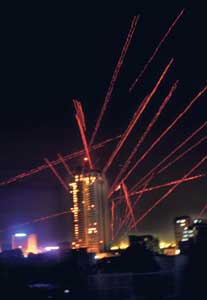
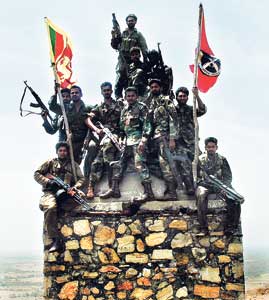

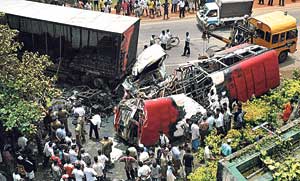
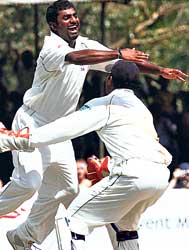
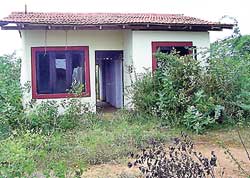


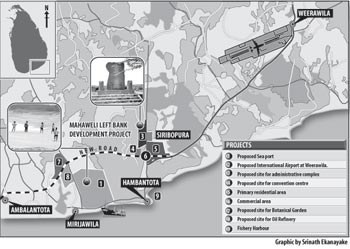
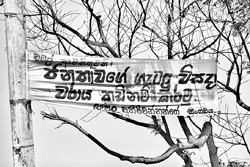
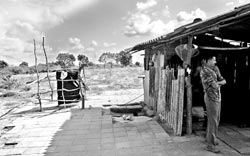


 Arugam Forum
Arugam Forum Arugam Photo Galleries on Picasa
Arugam Photo Galleries on Picasa Old Website
Old Website Press Coverage
Press Coverage Surf Forecast for Arugam Bay
Surf Forecast for Arugam Bay
TODAY’s Comments